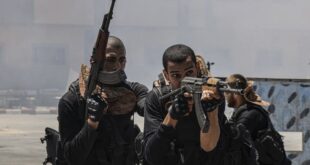GAZA CITY (AFP) — The Gaza Strip, the lesser half of the Palestinians’ promised future state, is home to 1.4 million residents who struggle against poverty and violence on the shores of the Mediterranean.
The Israeli army, which captured the territory from Egypt during the 1967 Six-Day War, in June launched its first serious ground offensive since leaving the territory on September 12, 2005 and handing control of empty Jewish settlements to the Palestinian Authority.
Each square kilometre shelters an average of 2,350 Palestinians, making it one of the most densely populated areas in the world.
Today the territory is the powerbase of Hamas, the Islamist group which won a shock election victory earlier this year and today heads a government boycotted politically and economically by the West.
Israel frequently closes the terminal at Rafah — the only international gateway to the outside world without going through Israel — on security grounds and has severely limited residents’ access to the Jewish state. For decades the Palestinian population lived alongside 8,000 Jewish settlers who enjoyed relative luxury and space on 33 per cent of the land taken up by 21 settlements which needed an Israeli army division to ensure their security.
Around 900,000 of the Palestinian population are refugees — those who were expelled or left their homes after the creation of Israel in 1948 — and their offspring. Half of those live in eight camps managed by the United Nations.
Situated to the southwest of Israel and bordering Egypt, the Mediterranean coastal region covers 362 square kilometres, some 45 kilometres in length by six to 10 kilometres wide.
Unemployment stands at around 45 per cent and the World Bank has estimated that two-thirds of the Gaza Strip population lives under the poverty line, earning less than $2 per day.
The World Bank also warned that EU and US aid cuts in the wake of Hamas’ election victory would adversely impact at least 30 per cent of the Palestinian population which is dependent on government salaries.
Israeli military checkpoints regularly hamper freedom of movement of people and goods inside the Palestinian territory.
Over the last six years, the army has carried out short sharp operations inside the Gaza Strip and along the almost-hermetic security barrier, set up to prevent Palestinian attacks in Israeli territory.
Some of the deadliest raids have seen Israel trying to stamp out arms smuggling from nearby Egypt via underground tunnels and to quell rocket and mortar attacks at Gaza settlements and southern Israeli towns.
An October 2004 campaign, concentrated mainly on the northern Gaza Strip, left 130 Palestinians dead and caused more than $3 million worth of damage, according to UN figures.
Palestinians hoped their living conditions would improve with the completion of Israel’s historic disengagement plan last year, but Israel maintains control of its territorial waters and airspace, and continues to inspect goods and monitor civilians entering from Egypt.
Although Israel destroyed all the settlers’ houses when they left last year, they left intact public infrastructure, including sewage and water plants and networks and controversially decided not to destroy synagogues.
Prime Minister Ehud Olmert’s government has vowed it does not aim to reoccupy Gaza, only to secure the release of a captured teenage soldier who was captured by Palestinian late June.
Israel’s assault since then has left 172 Palestinians dead, mostly civilians, and left the territory’s infrastructure in tatters.
 Eurasia Press & News
Eurasia Press & News
